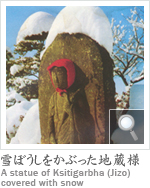|
 |

真言密教では護摩は尊い儀式です。護摩は、ハ梵語のホーマの音訳で梵焼と訳し本来火中に供物を投げ入れて火天に供養して諸願成就を祈願し幸福を増し災難を免れるようにしました。
一生懸命祈る心(信者)とご本尊様とお導師様(行者)が三者一体となり身、口、心が一つになって加持感応の行利益があらわれます。安福寺では、毎年二月三日節分会(追難会)が盛大に行われます。護摩札は魂の入ったご本尊の分身、分霊で南無大師遍照金剛あるいはご本尊様のご真言を唱えてご祈願ください。
|
 |
 |
In Shingon Sect of esoteric Buddhism, Goma is a sacred ritual. The term Goma is a phonetic transcription of a Sanskrit word “Homa” and means “to burn”.In the Goma ritual, people throw votive offerings into a bonfire in honor of Agni, or God of Fire, and prey for wish fulfillment, so that they can avoid sufferings as well as secure well-being.
The believers’ pious mind, the principal image, and the priests become one with one another; a body, a mouth, and a soul are united into one, so believers can feel a real resonance with Buddha and obtain merit. Ampuku-ji Temple holds a grand Setsubun ceremony (also called Tsuina ceremony) on February 3rd every year.
Goma wood is considered to be an alter ego or a divided spirit of the principal image. Pray to the principal image singing the mantra orNamu Daishi Henjo Gongo.
|
  |
 |
 
毎年節分の追難の儀式を当山では昭和二十四年より再興してより三十六回目を迎え悪事災難を払い家内安全を祈願して本堂一ぱいの善男善女を迎えて祈願護摩を開始、年男は裃に威儀を正し、空くじなしのくじによるだるま、ます、清酒などが当たって一年の安全厄払いを念じております。
|
 |
 |
At Ampuku-ji Temple,
‘Tsuina’, a ceremony of driving away evil spirits, was restarted in the 24th year of Showa Period ( 1949 ). Since then, thirty-six ceremonies, once every year, have been carried out. The ceremony is performed to wish for the safety of people’s family as well as to drive away evils and misfortunes, with the attendance of pious men and women jam-packing the main hall. Goma ritual starts at 8:00 pm on the day of the ceremony.‘Men of Year’, that is to say, the men who were born in a year with the same Chinese zodiac sign as the year of the ceremony are clad in old ceremonial costumes and attend the ceremony in a dignified manner. Lottery tickets are available on that day. Every ticket wins a prize, including Daruma ( a roly-poly paper doll modeled after Buddhist monk Bodhidarma ), Masu ( a wooden measuring container ), and Sake ( alcoholic beverage ), so that everyone can drive away evil spirits, wishing for the safety for the year. |
| |
  |
 |
|
 |

厄年とは・・・一生のうちで竹で言えば節目に当たる所です。この時期が精神的、肉体的に変化のある時期であり決して悪い年ではなく良い年と信じて自分をしっかり見つめて何事にも注意をする年でありこの時に仏様の慈悲にお願いをして安心した心で一日一日を大切に厄を受けないよう着実に歩む良い年にしたいと思われます。
|
 |
 |
| ‘Yaku age in one’s life’ can be compared to ‘a joint of a bamboo’. People at around Yaku age go through physical and mental changes. Therefore, people at Yaku age should have enough insight into themselves as well as be careful about things around them, believing that the year will turn out to be a good year rather than a bad one. They can make the year into a good one if they beg for mercy from Buddha, live each day with peace of mind, and try to avoid evils. |
 |
|
 |
 |
|
|
|

|
|
|
|
|
|
一月 |
一日 |
初詣り元旦護摩 |
|
|
二十一日 |
初大師 |
|
|
二十八日 |
初不動護摩厳修 |
|
|
|
|
|
|
|
|
| |
二月 |
|
節分会 |
| |
|
|
厄除け星祭り |
| |
|
|
|
| |
|
|
|
| |
三月 |
二十一日 |
彼岸会法要 |
| |
|
三十一日 |
相馬大師巡拝 (〜四月一日) |
| |
|
|
|
| |
|
|
|
| |
旧四月 |
八日 |
花祭り釈尊降誕会 |
| |
|
|
|
| |
|
|
|
| |
六月 |
十五日 |
青葉祭り |
| |
|
|
弘法大師誕生会 |
| |
|
|
|
| |
|
|
|
| |
八月 |
十三日 |
お盆入り |
| |
|
二十一日 |
施餓鬼会法要 |
| |
|
|
|
| |
|
|
|
| |
九月 |
|
秋彼岸会法要 |
| |
|
|
|
| |
|
|
|
| |
十二月 |
二十八日 |
不動護摩厳修(西大橋不動講) |
| |
|
三十一日 |
除夜の鐘(初詣り) |
|
 |
 |
| |
January |
|
|
| |
1st |
Goma ritual on New Year's Day |
|
| |
21st |
The first festival in honor of Kohboh-daishi |
|
| |
28th |
The first Goma ritual in honor of Acalanatha ( Fudo-myo-o ) |
|
| |
|
|
|
| |
|
|
|
| |
February |
|
|
| |
|
Setsubun Ceremony |
|
| |
|
Hoshi-matsuri, or Buddhist service for driving away evils |
|
| |
|
|
|
| |
|
|
|
| |
March |
|
|
| |
21st |
Higane, or Buddhist services during the spring equinoctial week |
|
| |
31st |
Going on pilgrimages to visit holly places called Soma-Daishi ( through to April 1st ) |
|
| |
|
|
|
| |
|
|
|
| |
April ( in the lunar calendar ) |
|
| |
8th |
Hana-matsuri, or Buddha's birthday festival |
|
| |
|
|
|
| |
|
|
|
| |
June |
|
|
| |
15th |
Aoba-matsuri, or Kohboh-daishi's birthday festival, held in the main hall |
|
| |
|
|
|
| |
|
|
|
| |
August |
|
|
| |
13th |
The first day of Bon Festival, or a festival to honor the departed spirits of one's ancestors |
|
| |
21st |
Segaki service for the benefit of suffering spirits |
|
| |
|
|
|
| |
|
|
|
| |
September |
|
| |
|
Higane, or Buddhist services during the autumn equinoctial week |
|
| |
|
|
|
| |
|
|
|
| |
December |
|
| |
28th |
Goma ritual in honor of Acalanatha ( Fudo-myo-o ) , held at the Nishi-Ohashi assembly |
|
| |
31st |
Ringing the temple bell 108 times on New Year's Eve to get rid of 108 worldly sins New Year’s visit to the temple |
|
| |
|
|
|
| |
|
 |
|
|
|
